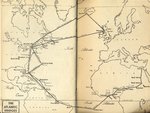pbfoot
1st Lieutenant
Just watched a documentary about Ferry Command and learned an interesting fact the RAF wouldn't supply pilots to ferry the aircraft as they thought it couldn't be done so Beaverbrook and the Austrailian Bennett were forced to recruit pilots bush pilots and crop dusters or those with low time and few skills to ferry aircraft across the North Atlantic . Another interesting fact was up to this point fewer then 100 flight had transited the pond.

